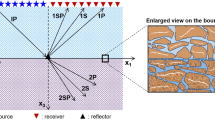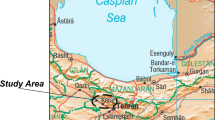Abstract
Ultrasonic wave stimulation shows potential in enhancing the permeability and production rate of low-permeability coal seam gas (CSG) reservoirs, however, the mechanisms of mechanical vibration induced by ultrasonic waves in coal is still unclear. In this paper, the effects of physical attributes of ultrasonic wave signals, including the incident angles and frequencies, on the propagation/attenuation of wave energy and cleat width variation are numerically analyzed. In the numerical modelling, the propagation direction of ultrasonic waves to the orientation of cleats varies from 0° to 90° by an 10° increasing range, and the frequency range of signals varies between 2 and 10 MHz with an increment of 2 MHz. To evaluate the changes of mechanical vibration near coal-cleats induced by the changes of physical attributes of ultrasonic waves, four parameters are discussed, including shear wave energy (SE), accumulation of wave energy (WE), cleat-width variation at each moment (D1(t)), and accumulation of cleat-width variation during a certain period (D2). Numerical simulation results show that: (1) wave signals with larger incident angles to the orientation of cleats contribute to larger SE, longer SE accumulation near cleat interfaces, and larger D1(t) and D2; (2) the ultrasonic waves at higher frequencies contribute to larger SE near cleat interfaces, which attenuates more easily during propagation. Meanwhile, the D1(t) becomes larger during the initial period when waves firstly arrive at the cleat. However, in the case of smaller frequencies, comparatively larger D1(t) lasts longer after waves leave from cleat, and D2 is larger during the overall stimulation.












Similar content being viewed by others
References
Agi, A., Junin, R., & Chong, A. S. (2018). Intermittent ultrasonic wave to improve oil recovery. Journal of Petroleum Science and Engineering, 166, 577–591.
Alhomadhi, E., Amro, M., & Almobarky, M. (2014). Experimental application of ultrasound waves to improved oil recovery during waterflooding: Journal of King Saud University. Engineering Sciences, 26(1), 103–110.
Amalokwu, K., Best, A. I., Sothcott, J., Chapman, M., Minshull, T., & Li, X.-Y. (2014). Water saturation effects on elastic wave attenuation in porous rocks with aligned fractures. Geophysical Journal International, 197(2), 943–947.
Aygün, H., & Barlow, C. (2015). Ultrasonic wave propagation through porous ceramics at different angles of propagation. Applied Acoustics, 88, 6–11.
Bergström, J., Holmberg, S., & Lehnert, B. (1961). Experiments on the energy balance and confinement of a magnetized plasma. Physical Review Letters, 6(10), 525–527.
Biot, M. A. (1956). Theory of propagation of elastic waves in a fluid-saturated porous solid. I. Low-frequency range. The Journal of the Acoustical Society of America, 28(2), 168–178.
Carcione, J. M., Kosloff, D., & Kosloff, R. (1988). Wave propagation simulation in a viscoelastic medium. Geophysical Journal of the Royal Astronomical Society., 93, 597–611.
Charrière, D., Pokryszka, Z., & Behra, P. (2010). Effect of pressure and temperature on diffusion of CO2 and CH4 into coal from the Lorraine basin (France). International Journal of Coal Geology, 81(4), 373–380.
Chen, H., Jiang, B., Chen, T., Xu, S., & Zhu, G. (2017). Experimental study on ultrasonic velocity and anisotropy of tectonically deformed coal. International Journal of Coal Geology, 179, 242–252.
Dawson, G. K. W., & Esterle, J. S. (2010). Controls on coal cleat spacing. International Journal of Coal Geology, 82(3–4), 213–218.
Hol, S., Peach, C. J., & Spiers, C. J. (2011). Applied stress reduces the CO2 sorption capacity of coal. International Journal of Coal Geology, 85(1), 128–142.
Jiang, Y., Song, X., Liu, H., & Cui, Y. (2015). Laboratory measurements of methane desorption on coal during acoustic stimulation. International Journal of Rock Mechanics and Mining Sciences, 78, 10–18.
Jiang, Y., & Xing, H. (2016). Numerical modelling of acoustic stimulation induced mechanical vibration enhancing coal permeability. Journal of Natural Gas Science and Engineering, 36, 786–799.
Kissinger, A., Helmig, R., Ebigbo, A., Class, H., Lange, T., Sauter, M., Heitfeld, M., Klünker, J., & Jahnke, W. (2013). Hydraulic fracturing in unconventional gas reservoirs: risks in the geological system, part 2. Environmental Earth Sciences, 70(8), 3855–3873.
Li, Q., Lin, B., & Zhai, C. (2014). The effect of pulse frequency on the fracture extension during hydraulic fracturing. Journal of Natural Gas Science and Engineering, 21, 296–303.
Li, X., Pu, C., Chen, X., Huang, F., and Zheng, H., 2021, Study on frequency optimization and mechanism of ultrasonic waves assisting water flooding in low-permeability reservoirs: Ultrasonics Sonochemistry, v. 70.
Liu, J.-X., Cui, Z.-W., & Wang, K.-X. (2012). Effect of stress on reflection and refraction of plane wave at the interface between fluid and stressed rock. Soil Dynamics and Earthquake Engineering, 42, 47–55.
Maligno, A. R., Rajaratnam, S., Leen, S. B., & Williams, E. J. (2010). A three-dimensional (3D) numerical study of fatigue crack growth using remeshing techniques. Engineering Fracture Mechanics, 77(1), 94–111.
Mazumder, S., Wolf, K. H. A. A., Elewaut, K., & Ephraim, R. (2006). Application of X-ray computed tomography for analyzing cleat spacing and cleat aperture in coal samples. International Journal of Coal Geology, 68(3–4), 205–222.
Mohsin, M., & Meribout, M. (2015). An extended model for ultrasonic-based enhanced oil recovery with experimental validation. Ultrasonics Sonochemistry, 23, 413–423.
Moore, B. A., Rougier, E., O’Malley, D., Srinivasan, G., Hunter, A., & Viswanathan, H. (2018). Predictive modeling of dynamic fracture growth in brittle materials with machine learning. Computational Materials Science, 148, 46–53.
Moore, T. A. (2012). Coalbed methane: a review. International Journal of Coal Geology, 101, 36–81.
Naderi, K., & Babadagli, T. (2010). Influence of intensity and frequency of ultrasonic waves on capillary interaction and oil recovery from different rock types. Ultrasonics Sonochemistry, 17(3), 500–508.
Paluszny, A., & Zimmerman, R. W. (2011). Numerical simulation of multiple 3D fracture propagation using arbitrary meshes. Computer Methods in Applied Mechanics and Engineering, 200(9–12), 953–966.
Ren, F., Ge, L., Stelmashuk, V., Rufford, T. E., Xing, H., & Rudolph, V. (2019). Characterisation and evaluation of shockwave generation in water conditions for coal fracturing. Journal of Natural Gas Science and Engineering, 66, 255–264.
Rose, J. L., & Nagy, P. B. (2000). Ultrasonic waves in solid media. The Journal of the Acoustical Society of America, 107(4), 1807–1808.
Shahani, A. R., & Amini Fasakhodi, M. R. (2009). Finite element analysis of dynamic crack propagation using remeshing technique. Materials & Design, 30(4), 1032–1041.
Shi, Q., Qin, Y., Li, H., Qiu, A., Zhang, Y., Zhou, X., & Zheng, S. (2016). Response of pores in coal to repeated strong impulse waves. Journal of Natural Gas Science and Engineering, 34, 298–304.
Shi, Q., Qin, Y., Li, J., Wang, Z., Zhang, M., & Song, X. (2017). Simulation of the crack development in coal without confining stress under ultrasonic wave treatment. Fuel, 205, 222–231.
Sun, W., Carcione, J. M., & Ba, J. (2015). Seismic attenuation due to heterogeneities of rock fabric and fluid distribution. Geophysical Journal International, 202(3), 1843–1847.
Tang, Z., Zhai, C., Zou, Q., & Qin, L. (2016). Changes to coal pores and fracture development by ultrasonic wave excitation using nuclear magnetic resonance. Fuel, 186, 571–578.
Thakur, P., 2017, Pore pressure and stress field in coal reservoirs. Advanced Reservoir and Production Engineering for Coal Bed Methane p. 61–73.
Virieux, J. (1986). P-SV wave propagation in heterogeneous media: velocity- stress finite difference method. Geophysics, 51(4), 889–910.
Wang, C., Feng, J., Liu, J., Wei, M., Wang, C., & Gong, B. (2014). Direct observation of coal–gas interactions under thermal and mechanical loadings. International Journal of Coal Geology, 131, 274–287.
Wang, H., Pan, J., Wang, S., & Zhu, H. (2015). Relationship between macro-fracture density, P-wave velocity, and permeability of coal. Journal of Applied Geophysics, 117, 111–117.
Wang, L. L., Vandamme, M., Pereira, J. M., Dangla, P., & Espinoza, N. (2018). Permeability changes in coal seams: The role of anisotropy. International Journal of Coal Geology, 199, 52–64.
Ward, C. R. (2016). Analysis, origin and significance of mineral matter in coal: an updated review. International Journal of Coal Geology, 165, 1–27.
Widera, M. (2014). What are cleats? Preliminary studies from the Konin lignite mine, Miocene of central Poland. Geologos, 20(1), 3–12.
Xu, W., Ok, J. T., Xiao, F., Neeves, K. B., and Yin, X., 2014, Effect of pore geometry and interfacial tension on water-oil displacement efficiency in oil-wet microfluidic porous media analogs. Physics of Fluids 26(9).
Yan, F., Lin, B., Zhu, C., Zhou, Y., Liu, X., Guo, C., & Zou, Q. (2016). Experimental investigation on anthracite coal fragmentation by high-voltage electrical pulses in the air condition: effect of breakdown voltage. Fuel, 183, 583–592.
Yi, J., & Xing, H. (2018). Finite element lattice Boltzmann method for fluid flow through complex fractured media with permeable matrix. Adv Water Resources, 119, 28–40.
Yu, H., Zhang, Y., Lebedev, M., Wang, Z., Li, X., Squelch, A., Verrall, M., & Iglauer, S. (2019). X-ray micro-computed tomography and ultrasonic velocity analysis of fractured shale as a function of effective stress. Marine and Petroleum Geology, 110, 472–482.
Zheng, H., Guo, Y., Zhu, H., Pan, D., Pan, L., & Liu, J. (2013). p-nitrophenol enhanced degradation in high-voltage pulsed corona discharges combined with ozone system. Plasma Chemistry and Plasma Processing, 33(6), 1053–1062.
Zhu, Y., Chen, Z., Xing, H., and Rudolph, V., 2019, Impact of capillary trapping on CSG recovery: an overlooked phenomenon. APPEA Journal, v. 59, no. 1.
Zou, Q., Lin, B., Zheng, C., Hao, Z., Zhai, C., Liu, T., Liang, J., Yan, F., Yang, W., & Zhu, C. (2015). Novel integrated techniques of drilling–slotting–separation-sealing for enhanced coal bed methane recovery in underground coal mines. Journal of Natural Gas Science and Engineering, 26, 960–973.
Author information
Authors and Affiliations
Corresponding authors
Additional information
Publisher's Note
Springer Nature remains neutral with regard to jurisdictional claims in published maps and institutional affiliations.
Rights and permissions
About this article
Cite this article
Zhao, Q., Xing, H. Simulation of Effects of Incident Angles and Frequencies of Ultrasonic Waves on Wave Energy Propagation and Variation of Cleat Width Induced by Ultrasonic Waves. Pure Appl. Geophys. 178, 1281–1296 (2021). https://doi.org/10.1007/s00024-021-02705-2
Received:
Revised:
Accepted:
Published:
Issue Date:
DOI: https://doi.org/10.1007/s00024-021-02705-2





